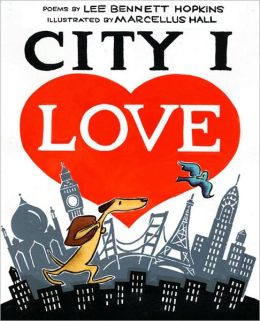
BIBLIOGRAPHY
Hopkins, Lee Bennett. 2009. CITY I LOVE. Ill. by Marcellus Hall. New York: Abrams Books for Young Readers. ISBN 978-0-8109-8327-4.
REVIEW AND CRITICAL ANALYSIS
CITY I LOVE by Lee Bennett Hopkins takes kids on a poetic adventure to several cities located in different parts of the world. A well traveled dog and his bird companion are the guides throughout each of the 18 poems included in the book. Hopkins uses sensory images in these short, but descriptive poems which allow the reader to easily escape to these urban centers. CITY I LOVE includes poems with rhythm, repetition, and occasionally rhyme to engage the young audience it is intended for.
Marcellus Hall's illustrations are full of details which perfectly compliment the poems and add even more to the already wonderful text. For example, in SUBWAYS ARE PEOPLE the illustration depicts a woman with a clothespin on her nose and a man playing an accordion among the people on the subway. The fact that a subway might smell or there might be musical entertainment isn't mentioned in the text, but the details in the illustrations help readers to add to their understanding of a subway in Mexico City. The accurate details about each city in both the illustrations and the text allow the reader to not only enjoy the poems, but learn from them too.
Taxi!
You stand
on a corner
shouting:
"Taxi!"
"Taxi!"
knowing
deep
inside
taxi cabs
never
stop
on
rainy
days.
In this succinct poem, Hopkins has captured a lot of emotion. Without the illustrations, the reader would most likely be unable to determine what city the poem is about. Included in the illustration of TAXI! are double decker buses with a Union Flag on the front, Big Ben, Tower Bridge, and the London Eye. Knowing that London is known for its rain showers along with the clues in the illustrations will help kids understand the poem is about London. Although none of the city names are explicitly written in the poems, a map is included in the front and back of the book that pinpoints each city that is written about in the book.
When studying about different types of communities (rural, suburban, and urban) these poems could be used to talk about the characteristics of urban communities they hear described in the poems and see in the illustrations.
The students could write their own poems about a place that they've been before without saying the name of the city or place. They should start by brainstorming ways to describe the place using their five senses. The illustration for their poem should add to the text and include details that would help the reader to imagine the place described.
Students could research more about one of the cities in the book. After learning more about the city, do they understand why Hopkins included different details in his poems?

No comments:
Post a Comment